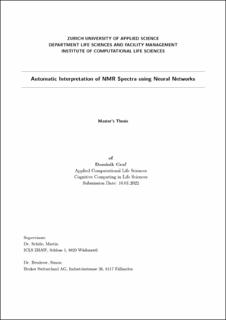Please use this identifier to cite or link to this item:
https://doi.org/10.21256/zhaw-27756| Publication type: | Master thesis |
| Title: | Automatic interpretation of NMR spectra using neural networks |
| Authors: | Graf, Dominik |
| Advisors / Reviewers: | Schüle, Martin Bruderer, Simon |
| DOI: | 10.21256/zhaw-27756 |
| Extent: | 85 |
| Issue Date: | 2022 |
| Publisher / Ed. Institution: | ZHAW Zürcher Hochschule für Angewandte Wissenschaften |
| Publisher / Ed. Institution: | Winterthur |
| Language: | English |
| Subjects: | Neural networks; Deep learning; NMR; Machine learning; Peak detection; Concentration determination; NMR simulation |
| Subject (DDC): | 540: Chemistry |
| Abstract: | Nuclear magnetic resonance spectroscopy (NMR) can be used to elucidate the structure of individual molecules and to identify them. When measuring mixtures, the ratio of the concentration of the individual substances can also be determined. However, the evaluation of such spectra is very time-consuming. This work deals with the automation of this evaluation with the help of neural networks. Due to a lack of experimental data, the algorithms were tested exclusively on synthetic data.
In the first part of the work, an attempt was made to determine the concentration of the individual components directly with the help of a neural network. The spectrum was passed to the model without preprocessing and the model was supposed to output the concentrations directly. For this purpose, various network architectures were tested and optimised. The best results were achieved with a residual neural network (ResNet). This worked relatively well for a certain set of substances. To evaluate the accuracy of the result and especially to evaluate the results of spectra for which no predefined solution is available, a visual confirmation of the result should also be formed. Within the scope of this work, it was not possible to train a model for this task.
In a second part of the work, a network was used to localise the sections of a spectrum that are easy to interpret. These sections were then evaluated with the help of a genetic algorithm. This worked well for highly simplified problems. Thus this can be considered a successful proof of concept. Kernresonanzspektroskopie (NMR) kann zur Strukturaufklärung und Identifikation einzelner Moleküle verwendet werden. Bei Messungen von Gemischen kann zudem das Verhältnis der Konzentration der einzelnen Substanzen bestimmt werden. Die Auswertung solcher Spektren ist allerdings sehr zeitaufwendig. Diese Arbeit befasst sich mit der Automatisierung dieser Auswertung mithilfe von Neuronalen Netzen. Wegen einem Mangel an experimentellen Daten wurden die Algorithmen ausschliesslich auf synthetischen Daten getestet. Im ersten Teil der Arbeit wurde versucht die Konzentration der einzelnen Komponenten direkt mithilfe eines Neuronalen Netzes zu bestimmen. Das Spektrum wurde also unbearbeitet dem Modell übergeben und das Modell sollte die Konzentrationen direkt ausgeben. Hierfür wurden diverse Netzwerkarchitekturen getestet und optimiert. Dies hat für ein bestimmtes Set an Substanzen relativ gut funktioniert. Die besten Resultate konnten mit einem residual neural netzwerk (ResNet) erzielt werden. Um die Genauigkeit des Resultats zu bewerten und vor allem um Resultate von Spektren zu beurteilen, für die keine vorgegebene Lösung vorhanden ist, sollte zudem eine visuelle Bestätigung des Resultats gebildet werden. Im Umfang dieser Arbeit ist es nicht gelungen ein Modell auf diese Aufgabe zu trainieren. In einem zweiten Teil der Arbeit wurden mithilfe eines Netzwerkes die Ausschnitte eines Spektrums lokalisiert, die einfach zu interpretieren sind. Anschliessend wurden diese Ausschnitte mithilfe eines genetischen Algorithmus ausgewertet. Dies hat für stark vereinfachte Probleme gut funktioniert. Somit kann dies als gelungener Proof of Concept betrachtet werden. |
| URI: | https://digitalcollection.zhaw.ch/handle/11475/27756 |
| License (according to publishing contract): | CC BY-NC-ND 4.0: Attribution - Non commercial - No derivatives 4.0 International |
| Departement: | Life Sciences and Facility Management |
| Organisational Unit: | Institute of Computational Life Sciences (ICLS) |
| Appears in collections: | Masterarbeiten Life Sciences |
Files in This Item:
| File | Description | Size | Format | |
|---|---|---|---|---|
| 2022_Graf_Dominik_MSc_LS.pdf | 16.76 MB | Adobe PDF |  View/Open |
Show full item record
Graf, D. (2022). Automatic interpretation of NMR spectra using neural networks [Master’s thesis, ZHAW Zürcher Hochschule für Angewandte Wissenschaften]. https://doi.org/10.21256/zhaw-27756
Graf, D. (2022) Automatic interpretation of NMR spectra using neural networks. Master’s thesis. ZHAW Zürcher Hochschule für Angewandte Wissenschaften. Available at: https://doi.org/10.21256/zhaw-27756.
D. Graf, “Automatic interpretation of NMR spectra using neural networks,” Master’s thesis, ZHAW Zürcher Hochschule für Angewandte Wissenschaften, Winterthur, 2022. doi: 10.21256/zhaw-27756.
GRAF, Dominik, 2022. Automatic interpretation of NMR spectra using neural networks. Master’s thesis. Winterthur: ZHAW Zürcher Hochschule für Angewandte Wissenschaften
Graf, Dominik. 2022. “Automatic Interpretation of NMR Spectra Using Neural Networks.” Master’s thesis, Winterthur: ZHAW Zürcher Hochschule für Angewandte Wissenschaften. https://doi.org/10.21256/zhaw-27756.
Graf, Dominik. Automatic Interpretation of NMR Spectra Using Neural Networks. ZHAW Zürcher Hochschule für Angewandte Wissenschaften, 2022, https://doi.org/10.21256/zhaw-27756.
Items in DSpace are protected by copyright, with all rights reserved, unless otherwise indicated.